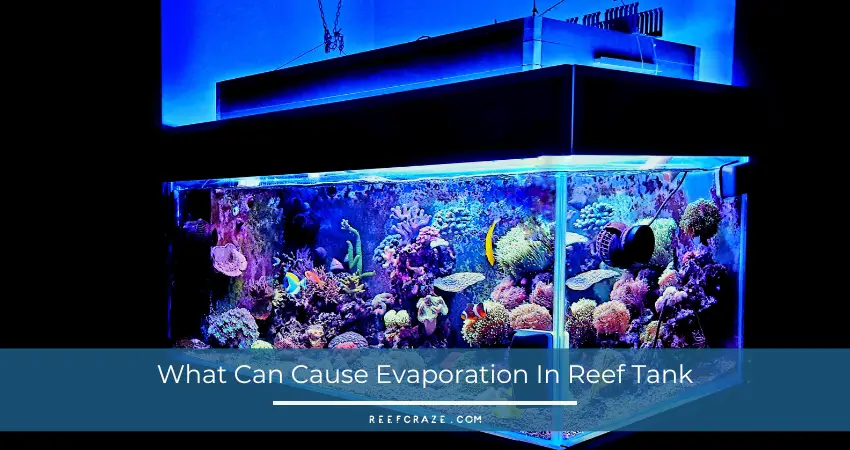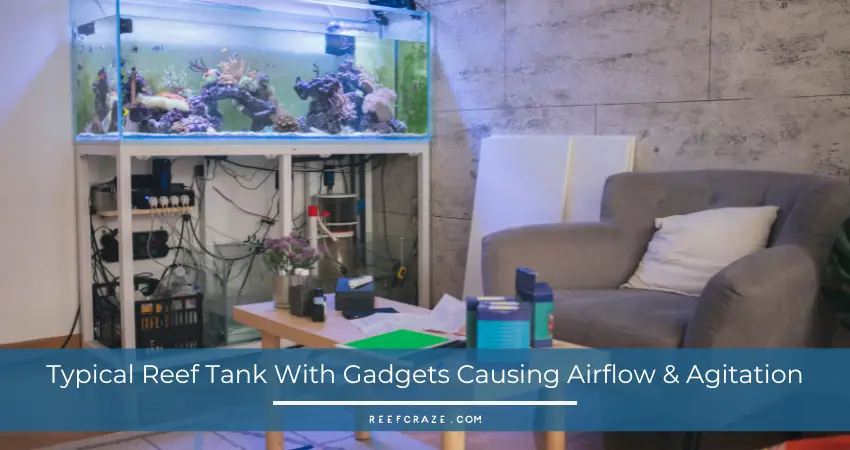Evaporation is an inevitable process in an open system like a fish tank. In a freshwater tank, it isn’t a major concern, but in a reef tank, it can be lethal. Saltwater evaporates slower than freshwater, but multiple factors in a reef tank can increase the evaporation rate drastically.
High temperature, water agitation, airflow, and filtration are the main culprits of evaporation in a reef tank. All of these processes constantly happen in your reef due to reef sumps, gyre or flow pumps, filtration systems, and air stones.
You can’t do without these components in your reef tank. But you can slow down the evaporation rate using some simple tricks. I’ll be giving an in-depth description of evaporation, how to slow it down, and an expensive but effective method of eliminating it in your reef tank.

What Is Evaporation? Why Is It Dangerous For Reef Tanks?
Evaporation is a natural process where water changes from liquid to vapor due to heat, agitation, or airflow. It happens in both closed and open systems. A fish tank is an open system where the lost water doesn’t condense back into the water.
For freshwater tanks, evaporation happens faster, but the water loss doesn’t affect fish for a week or even more. Evaporation will eventually cause the water levels to drop below livable conditions and cause nitrate, nitrite, and copper content to become concentrated. However, reef tanks have it much worse.
Typically, saltwater evaporates slower than freshwater. The sodium and chlorine ions dissolved in the water increase surface tension and hold on to water molecules strongly, resisting evaporation. But everyday operations in reef tanks cause a lot of airflow and agitation in the water, transferring more energy to the water molecules.

The result is a higher rate of water loss from evaporation in reef tanks. And because reef tanks contain a higher percentage of salts, minerals, and other chemicals, evaporation concentrates these compounds to toxic levels. It takes only 1 week for a 40-gallon reef tank to lose 3.5 gallons and raise the concentration beyond acceptable limits.
Evaporation does not remove the dissolved contents with water. So, if you’re planning on adding more saltwater to the mix, you’ll only make the situation dire. The reef tank water will become more concentrated, causing poisoning, pH imbalance, and killing your fish.
What Causes Evaporation in Reef Tanks?
Believe it or not, every device in use in your reef tank helps your fish increase evaporation. These devices are meant to filter, regulate, and circulate water and air. These processes naturally involve the causes of evaporation in your reef tank. These are the biggest culprits.
- High Temperature.
- Water agitation.
- Airflow.
- Filtration.
1. Temperature
The temperature isn’t a direct measurement of heat but a good overall indication of the climate created in your reef tank. A warm temperature is common in reef tanks, but it can increase evaporation. Heat introduces energy into water molecules in your reef tank, weakening the surface tension and forming vapor.
Temperature also affects humidity, specifically relative humidity. The higher the temperature, the more water molecules are needed to saturate the air. Combined with the weaker bond in water molecules, the increased relative humidity can aggressively increase how much water your reef tank is losing.
2. Water Agitation
Agitating or circulating the water is important for reef tanks. Running water simulates natural aquatic conditions, keeping heat and the dissolved elements evenly distributed. It also introduces oxygen to the water and prevents toxin and algae buildup. It also helps stimulate your fish into swimming and being more active.
However, agitating water like this will also provide additional energy for the water molecules in the reef tank. The dissolved salt and mineral ions in the water cannot restrain the molecules against it. Active circulation also prevents surface tension from working, giving the molecules more opportunities to escape.
3. Airflow
Airflow is helpful for the same reasons water circulation or agitation is. Airflow helps prevent carbon dioxide buildup and introduces oxygen, keeping each batch of reef tank water going for longer. It helps stabilize the pH and toxin buildup and keeps the fish energetic.
Airflow also increases evaporation for similar reasons. The action is more passive, but air molecules pushing against water molecules transfer energy to them, weakening the bonds. Air is less dense than air, and it flows upward and breaks through the water’s surface. Aside from weakening surface tension, air also guides the water molecules upward, increasing the chances of evaporation.
4. Filtration
Filtration is essential in removing toxins from your reef tank water. But it causes airflow and circulates water, causing water evaporation to happen faster in a localized area. Mechanical filters cause this issue more than chemical filters, but every type of filtration causes evaporation.
Through filtration, water molecules are separated from any dissolved content. Whether mechanical or chemical, no version of filtration is efficient enough to return every water molecule to your reef tank. So, filtration combines two other causes of evaporation and adds to the trouble.
As you can see, every one of these causes is either unavoidable or beneficial to your reef tank. And every pump, filter, sump system, and air tube is going to introduce these issues. Curbing them is impossible, but you can reduce evaporation through other means.
How To Stop Evaporation In Reef Tank? Is There Any Permanent Solution?
You can reduce the effects of evaporation in your reef tank without too much headache or cost. But it will require regular monitoring and activity. If you’re more of a “set it and forget it” person, there’s also an expensive but effective way to achieve it.
Here are 5 ways you can reduce or stop the effects of evaporation in your reef tank.
- Put A Lid On It.
- Add Sponge Blocks.
- Regulate Temperature.
- Add Freshwater.
- Install An ATO.
1. Put A Lid On It
The simplest way to slow down evaporation is to put a glass lid on top of your reef tank. Glass is a bad heat conductor. It will prevent the outside temperature from affecting your tank climate, and allow the vapor to collect and condense into droplets. Most importantly, it will not block your view.
2. Add Sponge Blocks
Protein skimmers, filters, and air circulation systems can cause too much agitation in the water. In this case, add sponge blocks that’ll localize and prevent the flow from affecting the entirety of your reef tank. It won’t completely prevent evaporation, but localization will cause your tank to lose water much slower.
3. Regulate Temperature
Regulating temperature is possibly the most effective preventive method. Less temperature means less energetic water molecules, less relative humidity, and therefore less evaporation.
You can find cheap heating solutions for reef tanks, but to prevent evaporation, you’ll want a more expensive temperature controller. A proper controller can cost from $50-$550, depending on the size and activity of your tank.
4. Add Freshwater
As you know, evaporation doesn’t take away the dissolved content, only water. To combat it, you have to add fresh water each week. A 40-gallon tank will need 3.5 gallons of freshwater every week.
To avoid any risk of unknown solutes in the water, you can use distilled water. But it’s best to use RO/DI filtered water instead, as you’ll eliminate any possibility of solutes.
5. Install An ATO (Auto-Top-Off System)
A more permanent and hands-off solution for how to stop evaporation in reef tank is installing an Automatic Top-Off System. The ATO will actively track the reef tank’s water levels and the solutes in it and add in water as needed.
This method can seem attractive, but it’s expensive. You’ll have to spend $200 or above to get a proper ATO that handles everything by itself. Typical ATOs will require you to fill them up and don’t contain a lot of water, so they aren’t as helpful as advertised.
Parting Words
Reef tanks aren’t closed systems, so you cannot completely stop evaporation from causing water loss. But you don’t have to spend hundreds of dollars to solve the issue. If you maintain your reef tank by yourself anyway, a glass lid and sponge blocks will slow evaporation down enough that you can worry about water levels every other week.

